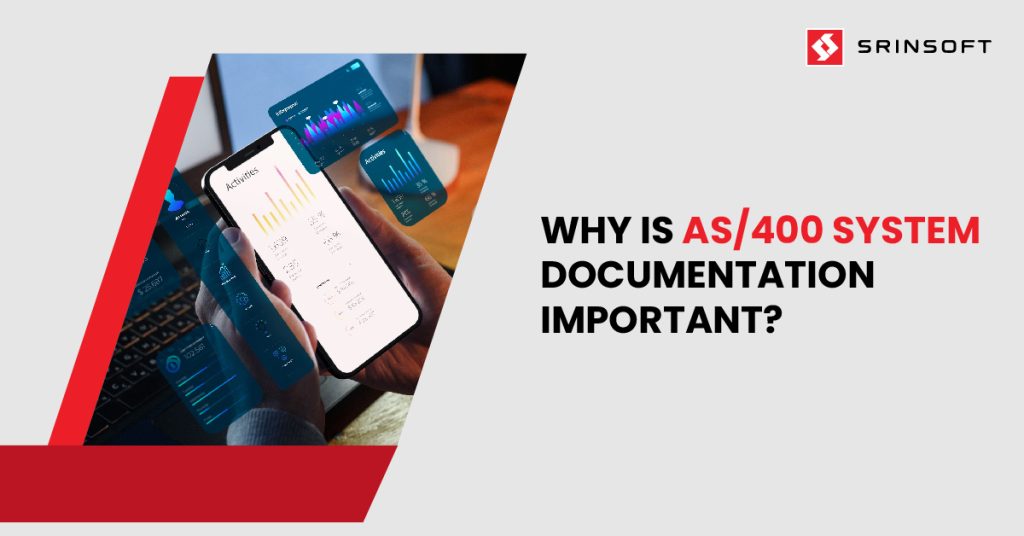
What Entails in AS400 System Documentation?
System documentation consists of minute details of AS400, leading to an organized way of managing and understanding the system as well as monitoring the overall health of the system. Here are some of the fundamentals of a good AS400 documentation:
If you’re exploring next steps, our IBM i documentation services can help you accelerate outcomes without disrupting current operations
1) General System Documentation
This consists of comprehensive documentation of iSeries system hardware, configurations, server models and operating systems which are being used.
This documentation is crucial for disaster recovery and technology upgrades, as it provides a concise overview of the system’s architecture and specifications.
2) DevOps Documentation
Besides infrastructure, documentation needs to span process and workflows to integrate IT operations with development teams.
This requires logging code modifications, version control systems, user roles and responsibilities, network configurations, and deployment methodologies (like A/B tests and shadow deployments).
3) Process Documentation
Process-related documentation outlines task flows, system manuals, workflow navigation, and user journey mappings.
Training new users, staff, and teams to maintain consistent operational processes is vital, and these records are indispensable in achieving that objective.
4) Integration Documentation
Documenting integrations is essential for modern AS400 systems due to their complexity. Information such as custom adapters, integration standards, and types of integrations used (like EDI, APIs, Webhooks) is included.
These records facilitate troubleshooting further supporting interoperability with other systems.
Why Companies Struggle with AS400 System Documentation?
Documenting AS400 systems is an extremely important task that many enterprises neglect. Although AS400 documentation is essential, several challenges can prevent organizations from starting or continuing proper AS400 documentation.
a) Dwindling Expertise
The AS400 solution has been around for decades and is typically run by seasoned RPG programmers and IT professionals who are approaching retirement.
Adding to the problem is a lack of new talent pipeline to replace them, as modern developers are not familiar with the system which further deepens the issue
This declining pool of resources forces enterprises to depend on a narrowing group of specialists, frequently relegating documentation activities to a lower priority.
b) Perceived Lack of Urgency
AS400 systems have existed for so long, that most existing AS400 teams know their way around quite well.
However, this reliance on the expertise of a few creates a false sense of security that often leads businesses to skip the documentation process, under the impression that it is not required, until critical knowledge gaps become apparent.
c) High Cost and Effort
AS400 System documentation requires dedicating time, effort, and financial resources to setup; not to mention the ongoing maintenance costs.
Organizations consider this a low-return activity that pales in comparison with their other IT efforts, so documentation is often delayed or deprioritized.
d) Resource Constraints
AS400 systems often weigh heavily on IT teams for resolving system issues or handling requests from users. As their bandwidth is occupied managing day-to-day operations, documentation is pushed to the backburner and leaves enterprises with incomplete or outdated records.
e) Growing Complexity of Legacy Systems
AS400 systems have often been developed and refined over decades, rife with customizations and integrations, making documentation a labour-intensive effort.
Getting a grip of the system’s architecture for newer members of a team becomes nearly impossible when no proper records exist.
The Importance of Documenting the AS400 System
AS400 systems documentation is a key practice that ensures operational continuity, eases the troubleshooting process, and protects against future uncertainty.
The AS400 is a robust legacy system used in many companies. However, due to its long history and complexity, a well-tended documentation is required. Here are the key benefits:
a) Facilitates Faster Resolutions
When something goes wrong, complete system documentation allows for faster troubleshooting and resolution of issues. This provides granular details about integrations, how the code is functioning and what the network looks like.
This information allows developers and IT teams to quickly troubleshoot issues. Not only does this improve performance, but it also minimizes downtime and maintains business continuity.
b) Eases Technology and Data Migration
AS400 documentation becomes crucial when systems are required to be modernized or migrated. Migrating to modern systems or the cloud often involves complex integration and data transformation processes.
The risks, issues, and costs of such transitions can be minimized and streamlined with properly documented system details, including configurations and dependencies.
c) Supports Disaster Recovery
Complete AS400 documentation is a must for recovery in case of IT disaster. Legacy developers age out and modern developers may be less familiar with iSeries technology, which will make clear documentation critical to assure that disaster recovery plans will be implemented as needed.
This reduces downtime and safeguards key business functions in the event of a disaster.
d) Simplifies Staff Training
With the retirement of AS400 developers, new hires find it challenging to work with the system’s outdated architecture. Well-structured documentation acts as an internal training manual, reducing the learning curve for modern developers.
It serves as a guide to help ensure teams can quickly adapt to new technologies and maintain, manage and operate the system when expertise is lost over generations.
e) Enhances System Stability and Security
Detailed documentation is another contributing factor to AS400’s stellar reputation which is known for stability and security. It makes sure that the updates, maintenance, and enhancements done are right without affecting the system integrity.
This documentation helps teams understand the object-based design and single-level storage, which aid in implementing security measures.
f) Lowers Cost of Ownership
The low operational cost is one of the features that the AS400 offers, but bad documentation can make those savings end up in draining time through inefficiencies in troubleshooting or migrations.
This helps business avoid unnecessary costs related to system downtime, misconfigurations, or redundant efforts.
g) Ensures Flexibility and Scalability
Well-maintained documentation supports AS400’s adaptability, allowing hardware or software upgrades to be carried out without impacting other areas. Being able to adapt is critical for organizations that intend to grow processes without losing efficiencies.
Recommended Read: How to Transform AS400 Green Screen
Challenges That Arise Without AS400 System Documentation
Failing to create comprehensive AS400 system documentation has implications that will impact not only immediate functionality, but long-term growth as well. Below are the key challenges organizations face:
a) Training Inefficiencies
Without documentation, it takes a long time to train new programmers on the AS400 system. Without clear records, onboarding processes rely on scarce in-house expertise, causing challenges in familiarizing new hires with the technical and functional workflows of the system.
b) Limited Understanding of System Functionalities
Without the documentation, non-technical employees who interact with the IBM iSeries on a day-to-day basis often fail to get a grasp of how the system operates fully.
Given this knowledge gap, informal training and trial-and-error methods only make the risk of operational disruptions more prevalent.
c) Extended Query-Resolution Times
Without a reference that maps how the system is structured and what the system can do, requests from users must be researched ad hoc, making it a tedious process.
IT teams have an increased investigation time into a myriad of unknowns before a solution is reached, resulting in slower response times and lower productivity.
d) Hindered Modernization and Migration Efforts
The architecture of the system needs to be well understood for modernization or migration initiatives. The lack of documentation, makes assessing the current setup almost impossible, leading to major hindrances in adopting technology trends or going for competitive upgrades.
e) Strategic Growth Limitations
Lack of documentation limits the scope of strategic planning. CIOs and decisionmakers will not have the visibility required to understand the capabilities of the system and take informed decisions to scale or innovate, hindering opportunities for long-term growth.
Conclusion
Creating AS400 system documentation is a multi-faceted effort which requires convergence of technical information, operational workflows, and integration details.
The combination of resource scarcity, cost concerns and operational pressure leaves companies unable to document their AS400 systems.
However, when left unaddressed, these challenges can eventually lead to long-term inefficiencies, knowledge silos, and higher risks around transitions, management and emergencies.
Having detailed and up-to-date documentation can help organizations increase system reliability, streamline training, and plan for future upgrades or transitions.








